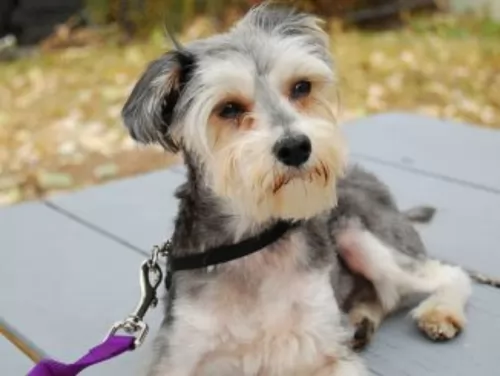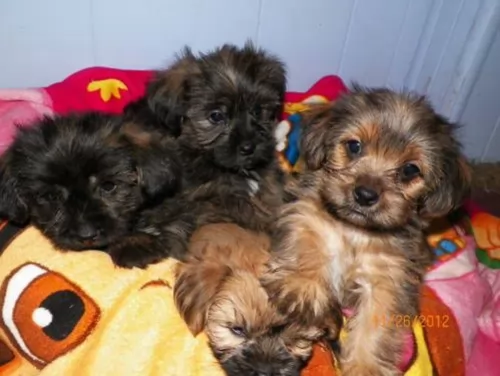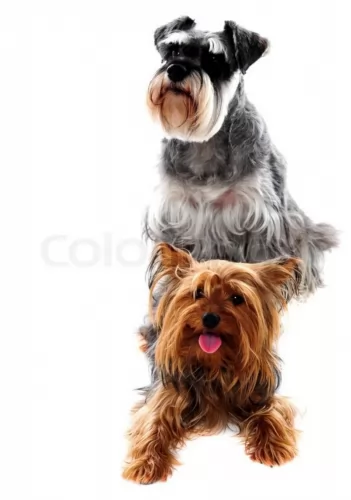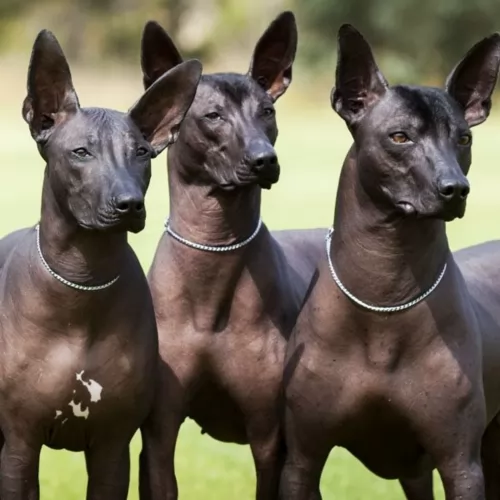 MyDogBreeds
MyDogBreeds Schnorkie is originated from United States but Mexican Hairless is originated from Mexico. Schnorkie may grow 28 cm / 11 inches shorter than Mexican Hairless. Schnorkie may weigh 16 kg / 35 pounds lesser than Mexican Hairless. Schnorkie may live 5 years less than Mexican Hairless. Schnorkie may have more litter size than Mexican Hairless. Schnorkie requires Moderate maintenance. But Mexican Hairless requires Low maintenance
Schnorkie is originated from United States but Mexican Hairless is originated from Mexico. Schnorkie may grow 28 cm / 11 inches shorter than Mexican Hairless. Schnorkie may weigh 16 kg / 35 pounds lesser than Mexican Hairless. Schnorkie may live 5 years less than Mexican Hairless. Schnorkie may have more litter size than Mexican Hairless. Schnorkie requires Moderate maintenance. But Mexican Hairless requires Low maintenance
 This dog is a cross between the Miniature Schnauzer and the Yorkshire Terrier.
This dog is a cross between the Miniature Schnauzer and the Yorkshire Terrier.
It’s not a purebred dog and is known as a designer dog. These dogs inherit characteristics from both of its purebred parents.
The origins and history of these breeds is often unknown with their being no records as to when or where breeders started developing them. This particular mixed breed dog originated in the United States.
 Who can believe that the origin of these dogs which hail from Mexico, goes back more than 3,500 years?
Who can believe that the origin of these dogs which hail from Mexico, goes back more than 3,500 years?
Known as the Xoloitzcuintli dog or Xolo for short, they comes in different sizes – toy-, miniature and standard which means there are different sizes. Both coated- and hairless dogs can be found in the same litter.
There was a time when the dog nearly became extinct buts its numbers have recovered. This is no doubt because there was a time when the natives ate the dog’s flesh.
 The Schnorkie is a small dog standing at between 12 to 30cm in height and weighing just 3 to 6kg.
The Schnorkie is a small dog standing at between 12 to 30cm in height and weighing just 3 to 6kg.
Schnorkies have an athletic build but they are lean and you want to keep them that way.
Their double coat is mostly silky and straight, but can be wavy too. The double coat can be grey, silver, fawnish and have a mix of colors while also being available in solid colors.
The ears are half erect, half floppy and the tail tends to be medium length, plumed and held up.
Schnorkies are high spirited little dogs and they can also prove to stubborn. There is nothing that a bit of training and socialization won't do for stubborn dogs, making them obedient and responsive to their owners.
Because they are hybrid dogs, they can inherit temperaments or looks from either of the parent dogs.
 The Mexican Hairless is truly an ancient dog breed of the Americans. He stands at 35 – 58cm if he is the standard variety whereas the miniature will stand at up to 35cm. Weight can vary too, but with the standard variety, you're talking about 16 to 22kg.
The Mexican Hairless is truly an ancient dog breed of the Americans. He stands at 35 – 58cm if he is the standard variety whereas the miniature will stand at up to 35cm. Weight can vary too, but with the standard variety, you're talking about 16 to 22kg.
It has faced times of nearly being extinct but it’s numbers have recovered, and the dog is often sought after for those who suffer with dog-hair allergies. You could say that this dog’s most notable characteristic is its lack of hair and the soft skin.
Some of them have small tufts of hair on the hair, mostly around the top of the head. The skin can be various shades of gray to bronze and a yellowish color too. His body is slightly longer than its height and he is slim and well muscled. The tail is long and thin and is sometimes carried high. You can expect 2 – 5 puppies from these dogs.
Anyone acquiring a Xolo will discover that this is an intelligent dog breed and that just like with other dogs, you’ll be able to have him trained and socialized easily. Then he is obedient and a pleasure to have around.
He is active too and will require games with balls and ropes as well as a daily walk. The Xoloitzcuintli is noted for its calm demeanor. The puppies are a lot noisier than the adults and very energetic and this continues till they are about 2 years of age when they are considered to be adult.
Well raised Xolos form strong bonds with their human family, becoming loyal and devoted.
 Your Schnorkie is a jaunty little dog who is going to love playing games with you. Children will need to treat him with gentleness and respect simply because he is small.
Your Schnorkie is a jaunty little dog who is going to love playing games with you. Children will need to treat him with gentleness and respect simply because he is small.
He is social, friendly and loving with his human family, though sometimes, coming from the Schnauzer, he gets a bit moody.
He makes a great family pet though and and while he loves to be outside playing, he also loves to come indoors and be everybody’s lap dog for the evening.
 The Xolo is one of those dogs who don’t get ill easily. He is also intelligent and fairly easy to train. Add to that the fact that he is also a low maintenance dog as he doesn’t have a coat that needs brushing and grooming.
The Xolo is one of those dogs who don’t get ill easily. He is also intelligent and fairly easy to train. Add to that the fact that he is also a low maintenance dog as he doesn’t have a coat that needs brushing and grooming.
Give your Xolo lots of attention because in exchange for the good care you give him, you’re going to get a loyal, devoted pet who loves to be with you constantly.
 Your Schnorkie, as a hybrid breed, can inherit some health problems from either parent – the Schnauzer or the Yorkshire Terrier.
Your Schnorkie, as a hybrid breed, can inherit some health problems from either parent – the Schnauzer or the Yorkshire Terrier.
Then again, mixing pure bred dogs can eliminate some common dog ailments. Overall, the Schnorkie is a healthy dog and can live up to 15 years of age.
A couple of major health concerns with the Schnorkie are dental problems and pancreatitis.
If your dog has tooth problems he might be in terrible pain and that is why it is so important to look inside his mouth.
Dogs can break their teeth and they can also get gum disease. Dogs have a more alkaline mouth and this is what encourages plaque. Try and brush your pet’s teeth with special canine toothpaste and toothbrush because dental disease can cause lots of problems for your pet.
The pancreas helps with the digestion of food and to regulate blood sugar. Pancreatitis is more common in Schnauzers, and then the pancreas is swollen and inflamed.
Dogs with this disease will lose their appetite, be lethargic, restless and have stomach pain. You may see your pet hunching his back. Pancreatitis can lead to organ damage and you will need to get your dog to the vet.
 The Xoloitzcuintli is a hardy dog in terms of health and can live to a ripe old age in dog years – some have been known to reach 18, 19 and 20 years of age. Without a coat, this dog is susceptible to sunburn so care must be taken when outdoors.
The Xoloitzcuintli is a hardy dog in terms of health and can live to a ripe old age in dog years – some have been known to reach 18, 19 and 20 years of age. Without a coat, this dog is susceptible to sunburn so care must be taken when outdoors.
Hairless dogs tend to battle with skin problems such as pimples. Skin allergies can cause itching and scratching and these can lead to bacterial infections. It is interesting to note that the genes that bring about hairlessness also produce troublesome teeth, so that dental disease is quite rife with these dogs.
 Puppies will need 4 small meals a day, but by 8 weeks your Schnorkie will be ready to move onto dry dog food. As he grows into an adult you will cut the meals down to two a day.
Puppies will need 4 small meals a day, but by 8 weeks your Schnorkie will be ready to move onto dry dog food. As he grows into an adult you will cut the meals down to two a day.
The best commercially manufactured dry dog food is able to meet your dogs nutritional needs and it’s super convenient too. It can be a good idea to feed your pet some home-made food too. Twice a week will be sufficient to add in this home-made food - boiled chicken, brown rice or pasta, sweet potatoes, carrots and spinach will be excellent for him and his digestion and be a tasty treat for him. You can simply chop it up and add it to the dry kibble. Some raw meat occasionally can help to ward off nasty skin ailments. Make sure that your Schnorkie has a constant supply of cool fresh water.
Schnauzers and Yorkies both have high maintenance coats and your Schnorkie will also require regular brushing, though he doesn’t shed much. Some people prefer to hand their dogs in and have them professionally groomed.
Just because a Schnorkie is a little dog, doesn’t mean he doesn’t need exercise. You don’t want a small dog like this getting obese and unfit. Take him for walks and give him some ball games.
 You’ve got to remember with this dog breed that he doesn’t have a coat so he can burn easily when out in the sun. If you know you’ll be in the sun for long, you’ll have to apply special sunscreen.
You’ve got to remember with this dog breed that he doesn’t have a coat so he can burn easily when out in the sun. If you know you’ll be in the sun for long, you’ll have to apply special sunscreen.
You can wipe down your Xolo or bath him from time to time, though not to often so as to strip the natural oils from the dog’s body. The nails will need to be trimmed regularly, as long nails can be a danger as they can hook on things and cause pain and bleeding.
Provide your hairless pet with a nice, soft bed to lie on.
Take him to the vet when he appears to be ill and see that you get his vaccinations done to prevent deadly illnesses such as rabies and parvo.
Check his eyes and ears for infections.
Brush his teeth to remove plaque. Never use human toothpaste. Take a look at the different canine toothpastes available.
Never leave your pet in a hot car with no windows open.
Provide your Xoloitzcuintli dog with high quality dog food so as to enhance health and longevity. Keep food simple for your pet to avoid digestive problems. Boiled chicken, brown rice or pasta and cooked potato, carrots and spinach can be chopped up and added to his dry kibble from time to time. Also a little bit of raw meat added in occasionally can also be excellent. Avoid feeding your pet foods such as onions, avocados, nuts, chocolate, coffee and raisins.
Make sure this dog has access to cool, fresh water night and day.